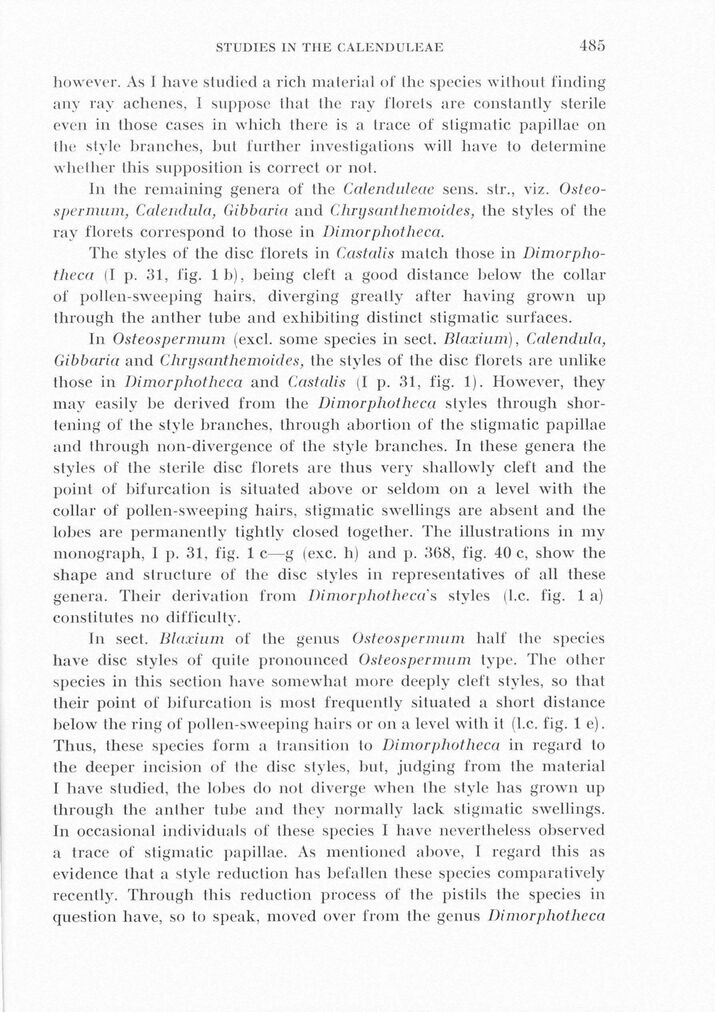
Full resolution (JPEG) - On this page / på denna sida - Sidor ...

<< prev. page << föreg. sida << >> nästa sida >> next page >>
Below is the raw OCR text
from the above scanned image.
Do you see an error? Proofread the page now!
Här nedan syns maskintolkade texten från faksimilbilden ovan.
Ser du något fel? Korrekturläs sidan nu!
This page has never been proofread. / Denna sida har aldrig korrekturlästs.
STUDIES IN THE CALENDULEAE
485
however. As I have studied a rich material of the species wilhout finding
any ray achenes, I suppose that the ray florets are constantly sterile
even in those cases in which there is a trace of stigmatic papillae ön
the style branches, hut further investigations will have lo determine
whether this supposition is correct or nol.
In the remaining genera of the Calenduleae sens. sir., viz.
Osteospermum, Calendula, Gibbaria and Chrysanthemoides, the styles of the
ray florets correspond lo Ihose in üimorphotheca.
The styles of the disc florets in Castalis match those in
Dimorpho-theca (I p. 31, fig. Ib), being cleft a good distance below Ihe collar
of pollen-sweeping hairs. diverging greatly after having grown up
through the anther tube and exhibiting distinct stigmatic surfaces.
In Osteospermum (excl. some species in seel. Blaxium), Calendula,
Gibbaria and Chrysanthemoides, the styles of the disc florets are unlike
those in Dimorphotheea and Castalis (I p. 31, fig. 1). However, they
may easily be derived from the Dimorphotheea styles through
shor-tening of the style branches. through abortion of the stigmatic papillae
and through non-divergence of the style branches. In these genera the
styles of the sterile disc florets are I hus verv shallowly cleft and the
point of bifurcation is situated above or seldom ön a level with the
collar of pollen-sweeping hairs, stigmatic swellings are absent and Ihe
lobes are permanently tightly closed together. The illustrations in mv
monograph, 1 p. 31, fig. 1 c—g (exc. h) and p. 368, fig. 40 c, show the
shape and structure of the disc styles in representatives of all these
genera. Their derivation from Dimorphotheea’s styles (I.e. fig. 1 a)
constilutes no difficulty.
In sect. Blaxium of the genus Osteospermum half the species
have disc styles of quite pronounced Osteospermum lype. The other
species in this section have somewhat möre deeply cleft styles, so that
their point of bifurcation is most frequently situated a short distance
below the ring of pollen-sweeping hairs or ön a level with il (I.e. fig. 1 e).
Thus, these species form a transilion lo Dimorphotheea in regard to
the deeper incision of Ihe disc slyles, hut, judging from Ihe material
I have studied, the lobes do not diverge wlien Ihe style has grown up
through the anther tube and they norinally lack stigmatic swellings.
In occasional individuals of Ihese species I have nevertheless observed
a trace of stigmatic papillae. As mentioned above, I regard this as
evidence that a slyle reduction has befallen Ihese species comparatively
recently. Through this reduction process of the pistils the species in
question have, so to speak, moved over from the genus Dimorphotheea
<< prev. page << föreg. sida << >> nästa sida >> next page >>